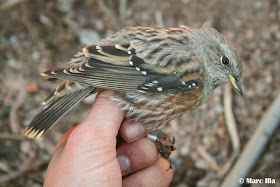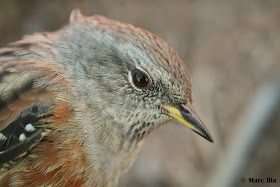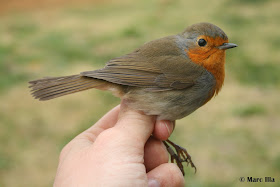Yeah!, I like the top 5 ranking. And especially when there's that many things to choose that makes almost an impossible decision to pick just 5!
Without more preable, here they go!
5- Falcons
If in the Top 5 2014 I placed "Eagles" in the number 5, this year is the turn to Falcons. With the invasion of Red-footed Falcons (Falco vespertinus) during May in Catalunya, and the "Falcon story" that you may have already heard about, this year I have actually trapped and ringed Red-footed, Peregrine, Hobby and Merlin. A very nice combo!

4- Illa de l'Aire
During May I spent some days in Illa de l'Aire, an small island south of Menorca, in the Balearic Islands. As always, I had very nice days with an incredible company. Thanks, one more time, to all Menorcan friends and see you in 2016!!

3- Morocco
In February I went to Morocco, for some days ringing in Yasmina lake and some days birding around the country. It was my second time there, but I enjoyed everything again as it was the first time. As Bald Ibis was selected in the 2013's top 5, this the picture will be about a Temminck's Lark (Eremophila bilopha), that was really tame close to Boumalne Dades.

2- 3900 ringed birds!
I just checked the total number of birds I have ringed in Catalunya this year: more than 3900. That's an actual lot, considering the places where I usually go and the fact that I am usually alone!
Anyway, big thanks to all friends that have come in one or another session for their help!! I kind of think 4000 birds will be hard to reach, but let's see...
Some birds from this year (click to enlarge!):
1- Falsterbo
Falsterbo is still on the first position, for the third year already. A part from the Falcon story, many other things happened, and with very nice friends around. I could tell that many things, that I'll just leave it remembering this Yellow-browed Warbler (Phylloscopus inornatus). A big hug to all my friends and... Vi ses!!!

All the best for 2016, another very nice year is just ready to start...
Molt bon any nou!
Without more preable, here they go!
5- Falcons
If in the Top 5 2014 I placed "Eagles" in the number 5, this year is the turn to Falcons. With the invasion of Red-footed Falcons (Falco vespertinus) during May in Catalunya, and the "Falcon story" that you may have already heard about, this year I have actually trapped and ringed Red-footed, Peregrine, Hobby and Merlin. A very nice combo!

4- Illa de l'Aire
During May I spent some days in Illa de l'Aire, an small island south of Menorca, in the Balearic Islands. As always, I had very nice days with an incredible company. Thanks, one more time, to all Menorcan friends and see you in 2016!!

3- Morocco
In February I went to Morocco, for some days ringing in Yasmina lake and some days birding around the country. It was my second time there, but I enjoyed everything again as it was the first time. As Bald Ibis was selected in the 2013's top 5, this the picture will be about a Temminck's Lark (Eremophila bilopha), that was really tame close to Boumalne Dades.

2- 3900 ringed birds!
I just checked the total number of birds I have ringed in Catalunya this year: more than 3900. That's an actual lot, considering the places where I usually go and the fact that I am usually alone!
Anyway, big thanks to all friends that have come in one or another session for their help!! I kind of think 4000 birds will be hard to reach, but let's see...
Some birds from this year (click to enlarge!):
1- Falsterbo
Falsterbo is still on the first position, for the third year already. A part from the Falcon story, many other things happened, and with very nice friends around. I could tell that many things, that I'll just leave it remembering this Yellow-browed Warbler (Phylloscopus inornatus). A big hug to all my friends and... Vi ses!!!

All the best for 2016, another very nice year is just ready to start...
Molt bon any nou!









































